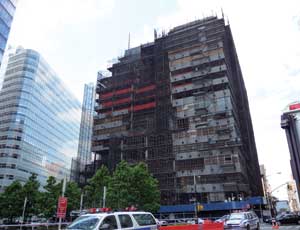Deconstruction After remediation was completed in late May, crews began the preliminary work on the deconstruction phase of the project. Windows wereremoved and the upper five floors of the facility encased in plywood. Diagonal cable bracing was installed around the gash and other areas the structural engineers identified for additional support.

A crane removed the plastic-encased elevator motors and emergency generator in the basement and also lifted four bobcats to the roof.
Two elevator shafts were designated as shoots for debris, one to handle steel and the other for concrete and brick.
The first step in the demolition process was to dismantle and cut up the superstructures on the roof, which were dropped to the floor below through a hole in the roof slab, says Richard Dalessio of the Dormitory Authority of the State of New York, the job’s project manager. With the superstructure down, the roof slab was demolished with pneumatichammers and the roof’s steel members dismantled. All the debris was dropped to the floor below and pushed down the appropriate shaft with the bobcats.
Deconstruction then moved down the building floor by floor. On each floor the concrete slab was broken up and dropped to the floor below and the steel floor members removed, says Andy Bachman, project executive for Tishman/LiRo, New York, the project’s construction manager.
The exterior brick walls and the knee walls were removed next. Removal of the exterior brick exposed the spandrel beams, which were coated with a nonfriable waterproofing mastic containing asbestos, Dalessio says. PAL Environmental scraped away the material using standard asbestos abatement procedures.
Airtek conducted monitoring and visual inspections of the demolition. “Once we deemed it visually clean, that section of beam was turned over to the contractor for its structural removal, Lewis says.
Throughout the process the team met with the regulators, the Department of Buildings and the NYC Fire Department to review the process and ensure everyone was communicating, Bachman says. The team also attended regular meetings with the community and local community board.
“CUNY made it clear that we had to engage the public and be open about the way the process was conducted,” Lewis says. “I think it was a wise decision, and it created a level of trust and confidence.”
Michael Stabulas, DASNY program director, adds: “I think the fact that we were open from the beginning and that we invited and received a lot of involvement from the community sharply reduced the level of mystery about the project and helped address neighborhood concerns and questions about what we were doing and how we were doing it.”
Demolition is slated for completion in October. Construction of the new 370,000-sq-ft Fiterman Hall, designed by Pei Cobb Freed & Partners, New York, will begin shortly thereafter.
Key Players
Owner: City University of New York
Project manager: The Dormitory Authority of the State of New York
Environmental consultant: Airtek Environmental Corp., New York
Abatement contractor: PAL Environmental Safety Corporation, Long Island City
Construction manager: Tishman/LiRo joint venture, New York
Deconstruction Contractor: Waldorf Exteriors LLC, Englewood, N.Y.
Structural Engineer: RSD Engineering, New York


Post a comment to this article
Report Abusive Comment